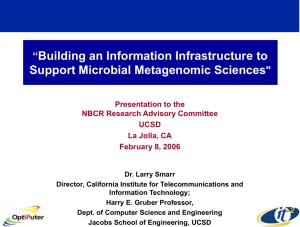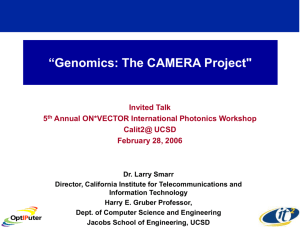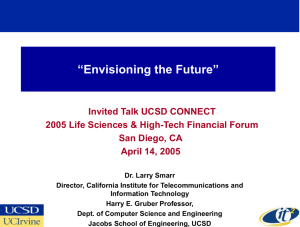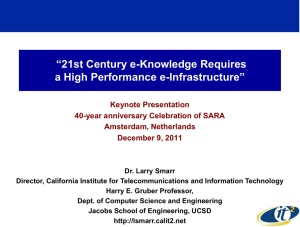PPT - Larry Smarr - California Institute for Telecommunications and
advertisement
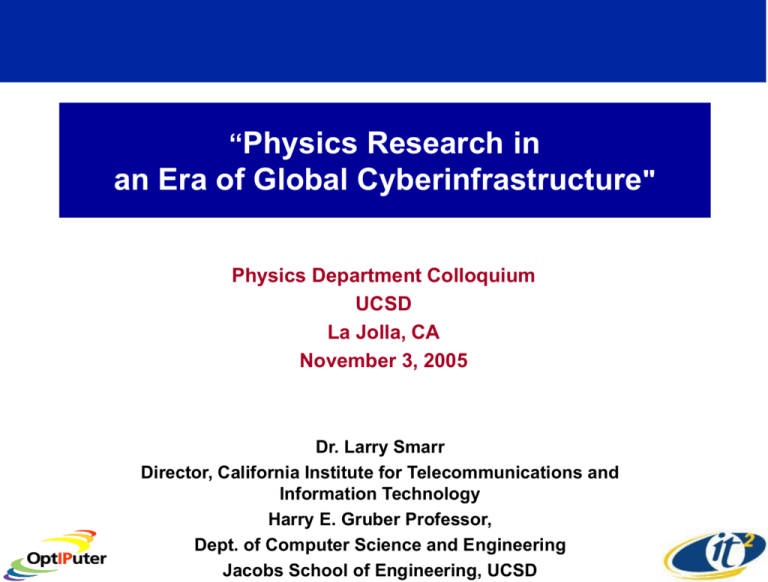
“Physics Research in an Era of Global Cyberinfrastructure" Physics Department Colloquium UCSD La Jolla, CA November 3, 2005 Dr. Larry Smarr Director, California Institute for Telecommunications and Information Technology Harry E. Gruber Professor, Dept. of Computer Science and Engineering Jacobs School of Engineering, UCSD Abstract Twenty years after the NSFnet launched today's shared Internet, a new generation of optical networks dedicated to single investigators are arising, with the ability to deliver up to 100-fold increase in bandwidth to the end user. The OptIPuter (www.optiputer.net) is one of the largest NSF-funded computer science research projects prototyping this new Cyberinfrastructure. Essentially, the OptIPuter is a “virtual metacomputer" in which the individual “processors” are widely distributed Linux clusters; the “backplane” is provided by Internet Protocol (IP) delivered over multiple dedicated lightpaths or "lambdas" (each 1-10 Gbps); and, the “mass storage systems” are large distributed scientific data repositories, fed by scientific instruments as OptIPuter peripheral devices, operated in near real-time. Furthermore, collaboration will be a defining OptIPuter characteristic; goals include implementing a next-generation Access Grid enabled with multiple HDTV and Super HD streams with photo realism. The OptIPuter extends the Grid program by making the underlying physical network elements discoveable and reservable, as well as the traditional computing and storage assets. Thus, the Grid is transformed into a LambdaGrid. A number of physics and astrophysics data-intensive project are prime candidates to drive this development. Two New Calit2 Buildings Will Provide Major New Laboratories to Their Campuses • New Laboratory Facilities – Nanotech, BioMEMS, Chips, Radio, Photonics, Grid, Data, Applications – Virtual Reality, Digital Cinema, HDTV, Synthesis • Over 1000 Researchers in Two Buildings – Linked via Dedicated Optical Networks – International Conferences and Testbeds UCOct. San Richard C. Atkinson Hall Dedication 28,Diego 2005 UC Irvine www.calit2.net Calit2@UCSD Creates a Dozen Shared Clean Rooms for Nanoscience, Nanoengineering, Nanomedicine Photo Courtesy of Bernd Fruhberger, Calit2 The Calit2@UCSD Building is Designed for Prototyping Extremely High Bandwidth Applications 1.8 Million Feet of Cat6 Ethernet Cabling Speed From Here UCSD is Only UC Campus with 10G CENIC Connection for ~30,000 Users Photo: Tim Beach, Calit2 Over 9,000 Individual 1 Gbps Drops in the Building ~10G per Person 150 Fiber Strands to Building; Experimental Roof Radio Antenna Farm Ubiquitous WiFi Why Optical Networks Will Become the 21st Century Driver Performance per Dollar Spent Optical Fiber (bits per second) (Doubling time 9 Months) Silicon Computer Chips (Number of Transistors) (Doubling time 18 Months) 0 1 2 3 Number of Years Scientific American, January 2001 Data Storage (bits per square inch) (Doubling time 12 Months) 4 5 Calit2@UCSD Is Connected to the World at 10Gbps Maxine Brown, Tom DeFanti, Co-Chairs iGrid 2005 THE GLOBAL LAMBDA INTEGRATED FACILITY www.igrid2005.org September 26-30, 2005 Calit2 @ University of California, San Diego California Institute for Telecommunications and Information Technology 50 Demonstrations, 20 Counties, 10 Gbps/Demo First Trans-Pacific Super High Definition Telepresence Meeting in New Calit2 Digital Cinema Auditorium Used 1Gbps Dedicated Keio University President Anzai UCSD Chancellor Fox Sony NTT SGI First Remote Interactive High Definition Video Exploration of Deep Sea Vents Canadian-U.S. Collaboration Source John Delaney & Deborah Kelley, UWash iGrid2005 Data Flows Multiplied Normal Flows by Five Fold! Data Flows Through the Seattle PacificWave International Switch A National Cyberinfrastructure is Emerging for Data Intensive Science Collaboration & Data Communication Tools & Tools & Services Services Education & Training High Performance Computing Tools & Services Source: Guy Almes, Office of Cyberinfrastructure, NSF Challenge: Average Throughput of NASA Data Products to End User is < 50 Mbps Tested October 2005 Internet2 Backbone is 10,000 Mbps! Throughput is < 0.5% to End User http://ensight.eos.nasa.gov/Missions/icesat/index.shtml Data Intensive Science is Overwhelming the Conventional Internet ESnet Monthly Accepted Traffic Through May, 2005 ESnet is Currently Transporting About 20 Terabytes/Day and This Volume is Increasing Exponentially ESnet Monthly Accepted Traffic Feb., 1990 – May, 2005 10 TB/Day ~ 1 Gbps 500 400 300 200 Feb, 05 Aug, 04 Feb, 04 Aug, 03 Feb, 03 Aug, 02 Feb, 02 Aug,01 Feb, 01 Aug, 00 Feb, 00 Aug, 99 Feb, 99 Aug, 98 Feb, 98 Aug, 97 Feb, 97 Aug, 96 Feb, 96 Aug, 95 Feb, 95 Aug, 94 Feb, 94 Aug, 93 Feb, 93 Aug, 92 Feb, 92 Aug, 91 Feb, 91 0 Aug, 90 100 Feb, 90 TByte/Month 600 Dedicated Optical Channels Makes High Performance Cyberinfrastructure Possible (WDM) c* f Source: Steve Wallach, Chiaro Networks “Lambdas” Parallel Lambdas are Driving Optical Networking The Way Parallel Processors Drove 1990s Computing National LambdaRail (NLR) and TeraGrid Provides Cyberinfrastructure Backbone for U.S. Researchers NSF’s TeraGrid Has 4 x 10Gb Lambda Backbone Seattle International Collaborators Portland Boise Ogden/ Salt Lake City UC-TeraGrid UIC/NW-Starlight Cleveland Chicago New York City Denver San Francisco Pittsburgh Washington, DC Kansas City Los Angeles Albuquerque Raleigh Tulsa Atlanta San Diego Phoenix Dallas Links Two Dozen State and Regional Optical Networks Baton Rouge Las Cruces / El Paso Jacksonville Pensacola San Antonio Houston NLR 4 x 10Gb Lambdas Initially Capable of 40 x 10Gb wavelengths at Buildout DOE, NSF, & NASA Using NLR Campus Infrastructure is the Obstacle “Research is being stalled by ‘information overload,’” Mr. Bement said, because data from digital instruments are piling up far faster than researchers can study. In particular, he said, campus networks need to be improved. High-speed data lines crossing the nation are the equivalent of six-lane superhighways, he said. But networks at colleges and universities are not so capable. “Those massive conduits are reduced to two-lane roads at most college and university campuses,” he said. Improving cyberinfrastructure, he said, “will transform the capabilities of campus-based scientists.” --Arden Bement, director National Science Foundation, Chronicle of Higher Education 51 (36), May 2005. http://chronicle.com/prm/weekly/v51/i36/36a03001.htm The OptIPuter Project – Linking Global Scale Science Resources to User’s Linux Clusters • NSF Large Information Technology Research Proposal – Calit2 (UCSD, UCI) and UIC Lead Campuses—Larry Smarr PI – Partnering Campuses: USC, SDSU, NW, TA&M, UvA, SARA, NASA • Industrial Partners – IBM, Sun, Telcordia, Chiaro, Calient, Glimmerglass, Lucent • $13.5 Million Over Five Years—Entering 4th Year • Creating a LambdaGrid “Web” for Gigabyte Data Objects NIH Biomedical Informatics Research Network NSF EarthScope and ORION UCSD is Prototyping Campus-Scale TheNational UCSDLambdaRail OptIPuter“On-Ramps” Deployment 0.320 Tbps Backplane Bandwidth Juniper T320 Campus Provided Dedicated Fibers Between Sites Linking Linux Clusters To CENIC SDSC SDSC JSOE Engineering 20X SOM 6.4 Tbps Backplane Bandwidth Medicine Phys. Sci Keck SDSC Annex SDSC Preuss Annex High School CRCA 6th College Collocation Node M Earth Sciences SIO Chiaro Estara ½ Mile Source: Phil Papadopoulos, SDSC; Greg Hidley, Calit2 UCSD Has ~ 50 Labs With Clusters Increasing Data Rate into Lab by 100x, Requires High Resolution Portals to Global Science Data Source: Mark Ellisman, David Lee, Jason Leigh, Tom Deerinck 650 Mpixel 2-Photon Microscopy Montage of HeLa Cultured Cancer Cells Green: Actin Red: Microtubles Light Blue: DNA OptIPuter Scalable Displays Developed for Multi-Scale Imaging 300 MPixel Image! Green: Purkinje Cells Red: Glial Cells Light Blue: Nuclear DNA Two-Photon Laser Confocal Microscope Montage of 40x36=1440 Images in 3 Channels of a Mid-Sagittal Section of Rat Cerebellum Acquired Over an 8-hour Period Source: Mark Ellisman, David Lee, Jason Leigh Scalable Displays Allow Both Global Content and Fine Detail Source: Mark Ellisman, David Lee, Jason Leigh 30 MPixel SunScreen Display Driven by a 20-node Sun Opteron Visualization Cluster Allows for Interactive Zooming from Cerebellum to Individual Neurons Source: Mark Ellisman, David Lee, Jason Leigh Campuses Must Provide Fiber Infrastructure to End-User Laboratories & Large Rotating Data Stores SIO Ocean Supercomputer IBM Storage Cluster UCSD Campus LambdaStore Architecture 2 Ten Gbps Campus Lambda Raceway Global LambdaGrid Source: Phil Papadopoulos, SDSC, Calit2 Streaming Microscope 5-Layer Demo Exercising the OptIPuter LambdaGrid Middleware Software “Stack” Applications (Neuroscience, Geophysics) Visualization Distributed Virtual Computer (Coordinated Network and Resource Configuration) 2-Layer Demo Novel Transport Protocols Optical Network Configuration Source-Andrew Chien, UCSD- OptIPuter Software System Architect 3-Layer Demo First Two-Layer OptIPuter Terabit Juggling on 10G WANs Source-Andrew Chien, UCSD SC2004: 17.8Gbps, a TeraBIT < 1 minute! UI atinChicago SC2005: 5-Layer Juggle--Terabytes per Minute 10 GE 10 GE 10 GE NIKHEF Trans-Atlantic Link PNWGP Seattle 10 GE StarLight Chicago NetherLight Amsterdam U of Amsterdam 10 GE 2 GE UCI 10 GE SC2004 Pittsburgh CENIC Los Angeles Netherlands United States 2 GE ISI/USC 10 GE CENIC San Diego UCSD/SDSC SDSC 10 GE 10 GE JSOE 2 GE CSE 10 GE 1 GE SIO UCSD Physics Department Research That Requires a LambdaGrid — The Universe’s Dark Energy Equation of State • Principal Goal of NASA-DOE Joint Dark Energy Mission (JDEM) • Approach: Precision Measurements of Expansion History of the Universe Using Type Ia Supernovae Standardizable Candles • Complimentary Approach: Measure Redshift Distribution of Galaxy Clusters – Must Have Detailed Simulations of How Cluster Observables Depend on Cluster Mass On The Lightcone for Different Cosmological Models Source: Mike Norman, UCSD SNAP satellite Cluster abundance vs. z Cosmic Simulator with a Billion Zone and Gigaparticle Resolution Problem with Uniform Grid-Gravitation Causes Continuous Increase in Density Until There is a Large Mass in a Single Grid Zone Source: Mike Norman, UCSD SDSC Blue Horizon AMR Allows Digital Exploration of Early Galaxy and Cluster Core Formation • Background Image Shows Grid Hierarchy Used – Key to Resolving Physics is More Sophisticated Software – Evolution is from 10Myr to Present Epoch • Every Galaxy > 1011 Msolar in 100 Mpc/H Volume Adaptively Refined With AMR – 2563 Base Grid – Over 32,000 Grids At 7 Levels Of Refinement – Spatial Resolution of 4 kpc at Finest – 150,000 CPU-hr On 128-Node IBM SP • 5123 AMR or 10243 Unigrid Now Feasible – 8-64 Times The Mass Resolution – Can Simulate First Galaxies – One Million CPU-Hr Request to LLNL – Bottleneck--Network Throughput from LLNL to UCSD Source: Mike Norman, UCSD Lightcone Simulation--Computing the Statistics of Galaxy Clustering versus Redshift Note Image is 9200x1360 Pixels Link to lc_lcdm.gif redshift ct (Gyr) 0 • -1 Evrard et al. (2003) – Single, 10243 P3M – L/D=104 – Dark matter only -2 -3 • -4 -5 Norman/LLNL Project – – – – Multiple, 5123 AMR Optimal Tiling of Lightcone L/D=105 Dark Matter + Gas Researchers hope to distinguish between the possibilities by measuring simply how the density of dark energy changed as the universe expanded. --Science Sept. 2, 2005 Vol 309, 1482-1483. AMR Cosmological Simulations Generate 4kx4k Images and Needs Interactive Zooming Capability Source: Michael Norman, UCSD Why Does the Cosmic Simulator Need LambdaGrid Cyberinfrastructure? • One Gigazone Uniform Grid or 5123 AMR Run: – Generates ~10 TeraByte of Output – A “Snapshot” is 100s of GB – Need to Visually Analyze as We Create SpaceTimes • Visual Analysis Daunting – Single Frame is About 8GB – A Smooth Animation of 1000 Frames is 1000 x 8 GB=8TB – Stage on Rotating Storage to High Res Displays • Can Run Evolutions Faster than We can Archive Them – File Transport Over Shared Internet ~50 Mbit/s – 4 Hours to Move ONE Snapshot! • AMR Runs Require Interactive Visualization Zooming Over 16,000x! Source: Mike Norman, UCSD Furthermore, Lambdas are Needed to Distribute the AMR Cosmology Simulations • Uses ENZO Computational Cosmology Code – Grid-Based Adaptive Mesh Refinement Simulation Code – Developed by Mike Norman, UCSD • Can One Distribute the Computing? – iGrid2005 to Chicago to Amsterdam • Distributing Code Using Layer 3 Routers Fails • Instead Using Layer 2, Essentially Same Performance as Running on Single Supercomputer – Using Dynamic Lightpath Provisioning Source: Joe Mambretti, Northwestern U Lambdas Enable Real-Time Very Long Baseline Interferometry • From Tapes to Real-Time Data Flows – Three Telescopes (US, Sweden) Each Generating 0.5 Gbps Data Flow – Data Feeds Correlation Computer at MIT Haystack Observatory – Transmitted Live to iGrid2005 – At SC05 will Add in Japan and Netherlands Telescopes • In Future, e-VLBI Will Allow for Greater Sensitivity by Using 10 Gbps Flows Global VLBI Network Used for Demonstration Source: MIT Haystack Observatory Large Hadron Collider (LHC) e-Science Driving Global Cyberinfrastructure pp s =14 TeV L=1034 cm-2 s-1 27 km Tunnel in Switzerland & France TOTEM CMS First Beams: April 2007 Physics Runs: from Summer 2007 ALICE : HI Source: Harvey Newman, Caltech ATLAS LHCb: B-physics High Energy and Nuclear Physics A Terabit/s WAN by 2010! Year Production Experimental 2001 2002 0.155 0.622 0.622-2.5 2.5 2003 2.5 10 DWDM; 1 + 10 GigE Integration 2005 10 2-4 X 10 Switch; Provisioning 2007 2-4 X 10 1st Gen. Grids 2009 ~10 X 10 or 1-2 X 40 ~5 X 40 or ~20 X 10 ~Terabit ~10 X 10; 40 Gbps ~5 X 40 or ~20-50 X 10 ~25 X 40 or ~100 X 10 2011 2013 ~MultiTbps Remarks SONET/SDH SONET/SDH DWDM; GigE Integ. 40 Gbps Switching 2nd Gen Grids Terabit Networks ~Fill One Fiber Source: Harvey Newman, Caltech Continuing the Trend: ~1000 Times Bandwidth Growth Per Decade; We are Rapidly Learning to Use Multi-Gbps Networks Dynamically The Optical Core of the UCSD Campus-Scale Testbed -Evaluating Packet Routing versus Lambda Switching Funded by NSF MRI Grant Goals by 2007: >= 50 endpoints at 10 GigE >= 32 Packet switched >= 32 Switched wavelengths >= 300 Connected endpoints Approximately 0.5 TBit/s Arrive at the “Optical” Center of Campus Switching will be a Hybrid Combination of: Packet, Lambda, Circuit -OOO and Packet Switches Already in Place Lucent Glimmerglass Chiaro Networks Source: Phil Papadopoulos, SDSC, Calit2 Multiple HD Streams Over Lambdas Will Radically Transform Global Collaboration U. Washington Telepresence Using Uncompressed 1.5 Gbps HDTV Streaming Over IP on Fiber Optics-75x Home Cable “HDTV” Bandwidth! JGN II Workshop Osaka, Japan Jan 2005 Prof. Smarr Prof. Osaka Prof. Aoyama Source: U Washington Research Channel Largest Tiled Wall in the World Enables Integration of Streaming High Resolution Video HDTV Calit2@UCI Apple Tiled Display Wall Driven by 25 Dual-Processor G5s 50 Apple 30” Cinema Displays 200 Million Pixels of Viewing Real Estate! Digital Cameras Digital Cinema Data—One Foot Resolution USGS Images of La Jolla, CA Source: Falko Kuester, Calit2@UCI NSF Infrastructure Grant OptIPuter Software Enables HD Collaborative Tiled Walls In Use on the UCSD NCMIR OptIPuter Display Wall • HD Video from BIRN Trailer • Macro View of Montage Data • Micro View of Montage Data • Live Streaming Video of the RTS2000 Microscope LambdaCam Used to Capture the Tiled Display on a Web Browser Source: David Lee, NCMIR, UCSD • HD Video from the RTS Microscope Room The OptIPuter Enabled Collaboratory: Remote Researchers Jointly Exploring Complex Data UCI OptIPuter will Connect The Calit2@UCI 200M-Pixel Wall to The Calit2@UCSD 100M-Pixel Display With Shared Fast Deep Storage “SunScreen” Run by Sun Opteron Cluster UCSD Combining Telepresence with Remote Interactive Analysis of Data Over NLR www.calit2.net/articles/article.php?id=660 August 8, 2005 SIO/UCSD OptIPuter Visualized Data HDTV Over Lambda NASA Goddard Optical Network Infrastructure Framework Needs to Start with the User and Work Outward Tom West, NLR California’s CENIC/CalREN Has Three Tiers of Service Calit2/SDSC Proposal to Create a UC Cyberinfrastructure of OptIPuter “On-Ramps” to TeraGrid Resources OptIPuter + CalREN-XD + TeraGrid = “OptiGrid” UC Davis UC San Francisco UC Berkeley UC Merced UC Santa Cruz UC Los Angeles UC Santa Barbara UC Riverside UC Irvine UC San Diego Creating a Critical Mass of End Users on a Secure LambdaGrid Source: Fran Berman, SDSC

